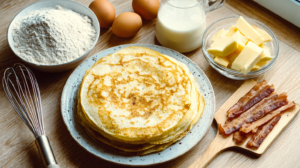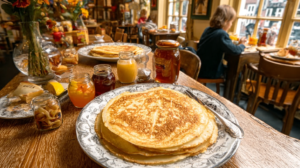Table of Contents
A Taste of the Netherlands on Your Plate
If you’ve ever explored Dutch cuisine, chances are you’ve come across Pannenkoeken, also known as Annenkoeken. These traditional Dutch pancakes are a beloved part of the culture — not to be confused with fluffy American pancakes or baked Dutch babies. Instead, they are large, thin, and incredibly versatile, often filled or topped with both savory and sweet ingredients.
A Family Tradition Passed Down Generations
The first time I tasted Annenkoeken, my Dutch partner prepared them as a nostalgic reminder of home. Unlike the thick and fluffy pancakes I was used to, these were wide and golden, laced with apple slices and crispy bacon, with syrup and jam on the side. They were unforgettable — not just because of the taste, but because of the warmth behind their preparation. This dish is a family heirloom in many Dutch households, passed down through generations by hands-on practice, not recipe cards.

What Makes Dutch Pancakes Special?
Unlike crepes or American-style pancakes, Pannenkoeken have a batter that’s slightly thicker than crepe batter but thinner than American pancake batter. They’re sturdy, allowing them to hold everything from bacon and cheese to fruit and herbs. And they’re huge—a typical homemade one stretches across the whole skillet, while restaurant versions can span more than 12 inches!
Pannenkoekenhuizen (pancake restaurants) are popular all across the Netherlands. Even more whimsical are the Pannenkoekenboten, pancake boats that cruise Dutch rivers, offering children and adults alike a floating feast.
Essential Tips for Making Perfect Annenkoeken
If you’re ready to try this Dutch classic, keep these tried-and-true tips in mind:
1. Use the Right Pan
Choose a well-seasoned cast-iron skillet or a reliable non-stick pan. Cast iron adds flavor but might need more butter to prevent sticking.
2. Don’t Stress About the First Pancake
Even seasoned Dutch cooks agree: the first pancake is rarely perfect. It’s okay if it’s a little wonky—it makes a great snack while you get into your groove.
3. Patience Is Key
Don’t rush the flip. Wait until the top of the pancake dries before turning it. If flipped too soon, the batter will spread messily.
4. Confident Flipping
Once you’ve mastered the technique, feel free to flip them mid-air like a pro — just don’t do it over the carpet!
Get Creative with Mix-Ins
What really makes Annenkoeken stand out is the variety of ingredients you can fold right into the batter as it cooks:
Fruit
Thin apple slices are traditional and lightly caramelize during cooking. Bananas, while rare in Dutch kitchens, are a delicious twist!
Bacon
Spekpannenkoeken are savory versions made by cooking strips of bacon in the pan, then pouring the batter on top. The result is a salty-sweet masterpiece.
Cheese
Dutch Gouda (pronounced how-dah) is the usual choice, but cheddar or other semi-firm cheeses work well too. Press slices into the batter and gently spread extra batter over the top to prevent burning.
Toppings: The Finishing Touch
Once cooked, the pancake is your canvas. Some classic and modern topping options include:
-
Stroop (Dutch syrup made from sugar beets)
-
Jam or fruit preserves
-
Honey or maple syrup
-
Apple butter
-
Fresh berries or fruit compote
-
Powdered sugar

The dark, thick stroop is less sweet than maple syrup, with a rich, earthy depth that perfectly complements both sweet and savory additions.
Annenkoeken Recipe: How to Make Dutch Pancakes
Prep Time: 5 mins
Cook Time: 30 mins
Total Time: 35 mins
Servings: 5
Yield: 10 medium or 5 large pancakes
Ingredients:
-
2 1/2 cups (300g) all-purpose flour
-
1/2 tsp kosher salt
-
2 cups (480ml) whole milk (add more to adjust thickness)
-
2 large eggs
-
3 tbsp butter (divided, for cooking)
Step-by-Step Instructions
1. Make the Batter
In a large mixing bowl, whisk together flour and salt. Add milk and eggs, whisking until smooth. The consistency should be thin enough to swirl easily in a pan but thick enough to hold shape.
Pro Tip: Batter too thick? Add more milk gradually.
2. Heat Your Skillet
Preheat your non-stick or cast-iron skillet over medium heat. Melt 1/2 to 1 tsp butter in the pan. Once foamy, swirl it to coat the surface evenly.
3. Cook the Pancakes
Remove the pan from heat briefly. Pour 1/2 to 2/3 cup batter (depending on your skillet size) into the center and swirl it out evenly. Return to heat and add any toppings like sliced apples, bananas, or cooked bacon. Lightly press them into the batter.
Cook for 2 minutes until the top looks dry, then flip and cook for another 1–2 minutes. The pancake should be golden and speckled.
Repeat with the rest of the batter and butter, stacking pancakes under a clean towel to keep warm.
4. Serve and Enjoy
Top your warm pancakes with syrup, fruit, or powdered sugar. Enjoy them hot for the best flavor and texture. Refrigerate leftovers and reheat in a microwave or enjoy cold — a surprisingly popular Dutch method!
Nutrition Facts (Per Serving):
-
Calories: 368
-
Fat: 13g
-
Carbohydrates: 51g
-
Protein: 12g
Note: Values may vary based on mix-ins and toppings.
Final Thoughts: Why You’ll Love Dutch Pancakes
Annenkoeken offer more than just a delicious meal — they’re a cultural experience. Whether you’re enjoying them on a canal boat in Amsterdam or at your own breakfast table, their rich flavor and versatility make them a household favorite. Try different combinations, serve them sweet or savory, and share the tradition with your family.

